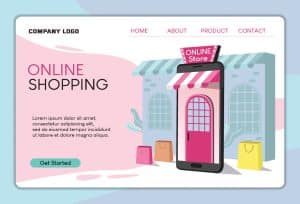Website Design in Online Shopping: The Art of Digital Storefronts
In the ever-evolving landscape of e-commerce, where the virtual marketplace is bustling with activity, the significance of website design cannot be overstated. The digital realm has transformed the way we shop, and at the heart of this transformation lies the intricate dance of aesthetics, functionality, and user experience that constitutes effective website design for online shopping platforms. What is website design in online shopping?
The Visual Symphony: Aesthetics in Website Design

The saying “don’t judge a book by its cover” may hold true in many contexts, but when it comes to online shopping, the visual appeal of a website can make or break a potential sale.
Color Palette and Branding:
Just as physical stores have distinctive storefronts, online shops must establish a visual identity through their color schemes and branding elements. Consistency in colors fosters a sense of familiarity and trust, while a coherent branding strategy reinforces the store’s identity in the customer’s mind. For online store website design read on.
Imagery and Product Presentation:
High-quality images are the lifeblood of online shopping. Customers cannot physically touch or try on products, so clear, detailed images are crucial. Designers must ensure that product images are displayed in multiple angles, enabling customers to gain a comprehensive view before making a purchase decision.
User-Centric Experience: Navigating the Digital Aisles
In the virtual realm, navigating the digital aisles must be as intuitive as strolling through a physical store.
Intuitive Navigation:
Online shopping websites should have a well-structured navigation menu that allows customers to effortlessly explore different product categories. A search bar prominently displayed on the page helps users find specific items quickly.
Mobile Responsiveness:
The rise of mobile devices as primary access points to the internet has made mobile responsiveness non-negotiable. Websites must adapt seamlessly to various screen sizes, ensuring a consistent shopping experience across devices.
Streamlined Checkout Process:
A convoluted checkout process can lead to cart abandonment. A user-friendly and streamlined checkout process with minimal steps enhances the overall experience and encourages customers to complete their purchases.

Under the Hood: Functionality and Performance
A visually appealing website is a great start, but it must also perform flawlessly to retain customers and encourage repeat business.
Fast Loading Times:
In the digital age, attention spans are shorter than ever. Slow-loading websites can deter customers and harm the website’s search engine ranking. Optimizing images, minimizing code, and utilizing content delivery networks (CDNs) can significantly improve loading times.
Secure Payment Gateway:
Security is paramount in online shopping. Integrating a secure and trustworthy payment gateway instills confidence in customers, assuring them that their sensitive information is protected.
Personalization:
Tailoring the shopping experience to individual customers through personalized recommendations based on their browsing and purchase history can enhance engagement and drive sales. https://cbdtax.com.au/ashfield-tax-agent/
Building Trust: Reviews, Testimonials, and Customer Support
Building trust in the online realm is a delicate process.

Product Reviews and Ratings:
Genuine product reviews and ratings from other customers provide social proof and help potential buyers make informed decisions. Allowing customers to leave reviews and ratings fosters a sense of community around the brand.
Responsive Customer Support:
Just as a friendly store assistant can make a positive impression in a physical store, responsive customer support through live chats or email can enhance the online shopping experience and address customer concerns promptly.
Conclusion
In the world of online shopping, a well-designed website is more than just a digital storefront; it’s a dynamic space where aesthetics, functionality, and user experience harmoniously intersect. From the choice of colors to the responsiveness of the checkout process, every aspect of website design plays a role in shaping the customer’s journey. By understanding the intricate balance between design elements and user needs, e-commerce platforms can create captivating digital shopping experiences that leave a lasting impact.
As online shopping continues to evolve, so too will the art of website design, ensuring that the virtual marketplace remains an engaging and efficient space for consumers to explore, connect, and shop.





